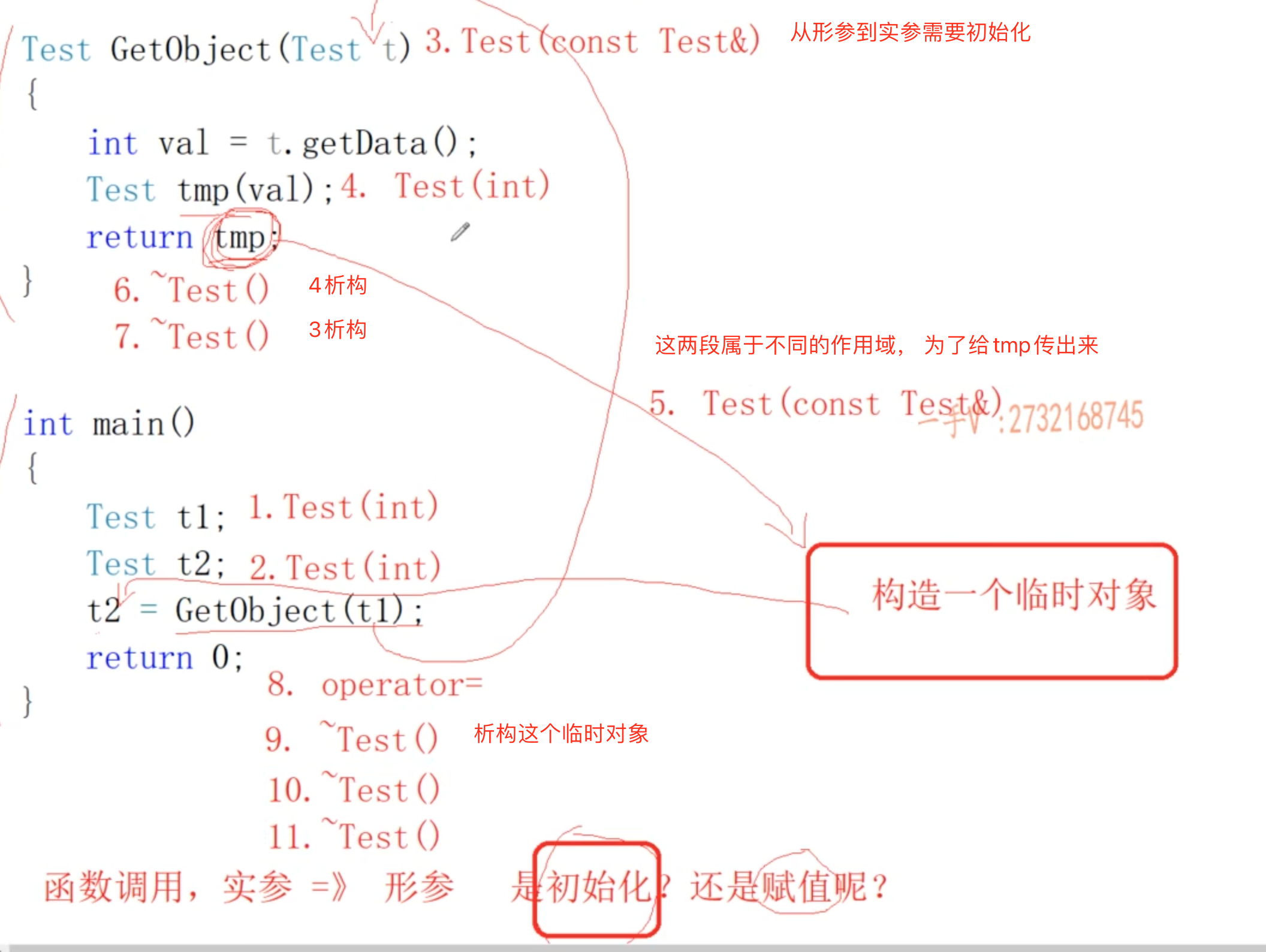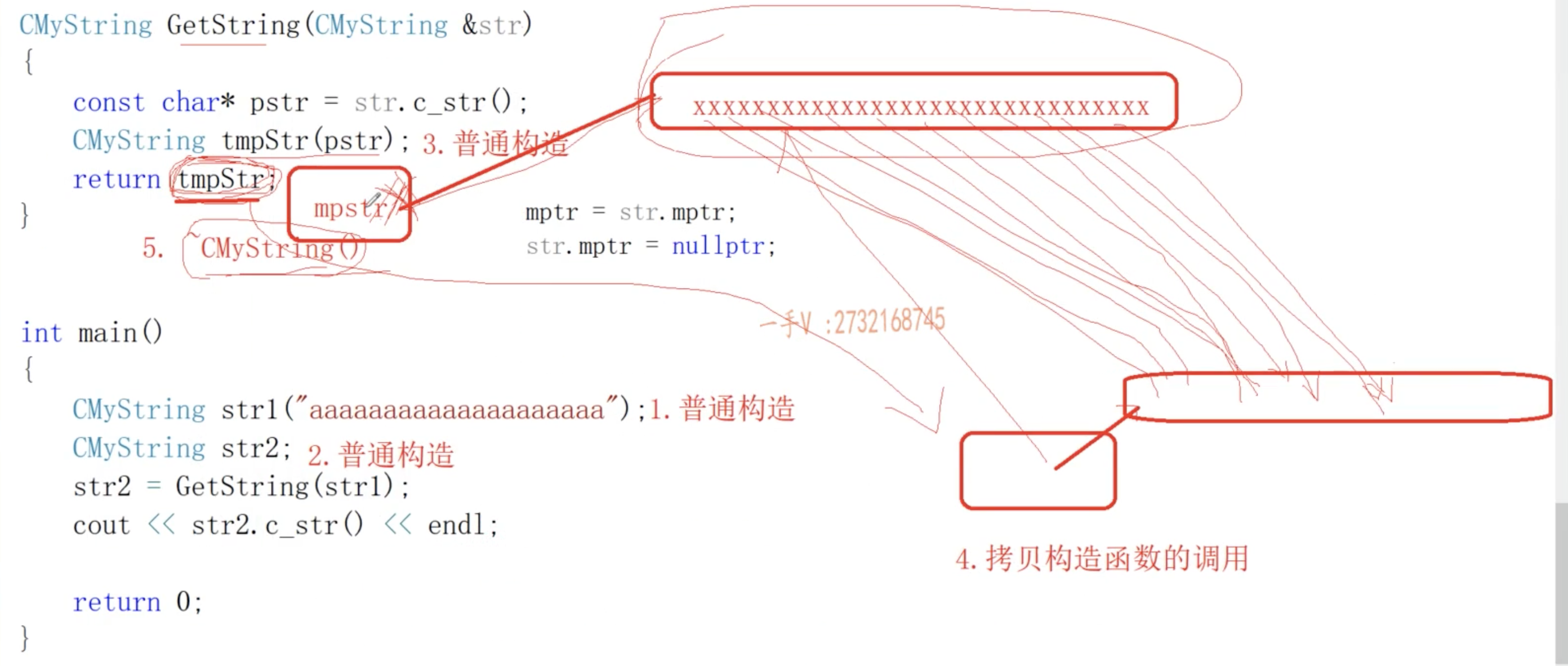对象被优化以后才是高效的C++编程
对象使用过程中背后调用了哪些方法
#include <iostream>
using namespace std;
class Test
{
public:
Test(int a = 10) :ma(a) { cout << "Test()" << endl; }
~Test() { cout << "~Test()" << endl; }
Test(const Test& t) : ma(t.ma) { cout << "Test(const Test&)" << endl; }
Test& operator=(const Test& t)
{
cout << "operator =" << endl;
ma = t.ma;
return *this;
}
private:
int ma;
};
int main()
{
Test t1;
Test t2(t1);
Test t3 = t1;
t3 = t1;
cout << "-------t3-------" << endl;
t3 = Test(30); //临时对象必须生成 生存周期:所在语句
cout << "-------t3-------" << endl;
//显示生成临时对象
//C++编译器对于对象构造的优化:用临时对象生成新对象时,
//临时对象就不产生了,直接构造新对象就可以了
//显示生成临时对象
Test t4 = Test(20); //和 Test t4(20); 没有区别
//显示生成临时对象
//构造 =重载赋值 析构
t4 = (Test)30; //int -> Test(int) 强制类型转换
//隐式生成临时对象
t4 = 30; //int -> Test(int)
cout << "----------" << endl;
Test* p = &Test(40); //出了语句对象析构了 不应该这样 不安全
const Test& ref = Test(50); //没有析构,相当于别名
cout << "----------" << endl;
return 0;
}
/*
Test()
Test(const Test&)
Test(const Test&)
operator =
-------t3-------
Test()
operator =
~Test()
-------t3-------
Test()
Test()
operator =
~Test()
Test()
operator =
~Test()
----------
Test()
~Test()
Test()
----------
~Test()
~Test()
~Test()
~Test()
~Test()
*/#include <iostream>
using namespace std;
class Test
{
public:
//Test() / Test(10)只传了a / Test(int, int)
Test(int a = 10, int b = 10) :ma(a), mb(b) { cout << "Test(int, int)" << endl; }
~Test() { cout << "~Test()" << endl; }
Test(const Test& t) : ma(t.ma), mb(t.mb) { cout << "Test(const Test&)" << endl; }
Test& operator=(const Test& t)
{
cout << "operator =" << endl;
ma = t.ma;
mb = t.mb;
return *this;
}
private:
int ma, mb;
};
Test t1(10, 10); //1. Test(int, int)
int main()
{
Test t2(20, 20); //3. Test(int, int)
Test t3 = t2; //Test (const Test&)
static Test t4 = Test(30, 30); //static Test t4(30, 30);静态局部变量内存是已经分配好的,但是是第一次运行时候才初始化
t2 = Test(40, 40); //Test(int, int) -> operator= -> ~Test()
//类型强转 (a=50, b=10)
//括号表达式是最后一个
t2 = (Test)(50, 50); //Test(int, int) operator= ~Test() (50, 50)是逗号表达式,(50, 50) = 50 , 这里也就是t2 = Test(50)
t2 = 60;
Test* p1 = new Test(70, 70); //Test(int, int)
Test* p2 = new Test[2]; //两次构造
Test* p3 = &Test(80, 80); //指针指向临时对象 语句结束析构
const Test& p4 = Test(90, 90); //Test(int, int)
cout << "-----------" << endl;
delete p1; //~Test()
delete []p2; //两次~Test()
cout << "-----------" << endl;
return 0;
}
Test t5(100, 100); //2.Test(int, int)
/*
Test(int, int)
Test(int, int)
Test(int, int)
Test(const Test&)
Test(int, int)
Test(int, int)
operator =
~Test()
Test(int, int)
operator =
~Test()
Test(int, int)
operator =
~Test()
Test(int, int)
Test(int, int)
Test(int, int)
Test(int, int)
~Test()
Test(int, int)
-----------
~Test()
~Test()
~Test()
-----------
~Test()
~Test()
~Test()
~Test()
~Test()
~Test()
*/
函数调用过程中对象背后调用的方法太多
#include <iostream>
using namespace std;
class Test
{
public:
Test(int data = 10)
:ma(data)
{
cout << "Test(int)" << endl;
}
~Test()
{
cout << "~Test()" << endl;
}
Test(const Test& t) :ma(t.ma)
{
cout << "Test(const Test&)" << endl;
}
void operator=(const Test& t)
{
cout << "operator=" << endl;
ma = t.ma;
}
int getData() const { return ma; }
private:
int ma;
};
//不能返回局部或临时的指针或引用
Test GetObject(Test t) //3. Test(const Test&)
{
int val = t.getData();
Test tmp(val); //4. Test(int)
return tmp; //5. Test(const Test&) tmp不能被拿出来
//6. ~Test() tmp
//7. ~Test() t
}
int main()
{
Test t1; //1. Test(int)
Test t2; //2. Test(int)
//实参到形参,初始化(两个对象)
t2 = GetObject(t1); //8 operator=
//9 ~Test() 临时对象析构
cout << "-----" << endl;
return 0;
}
/*
Test(int)
Test(int)
Test(const Test&)
Test(int)
Test(const Test&)
~Test()
~Test()
operator=
~Test()
-----
~Test()
~Test()
*/
总结三条对象优化的规则
- 函数参数传递过程中,对象优先按引用传递,不要按值传递
- 当函数返回对象的时候,应该优先返回一个临时对象,而不要返 回一个定义过的对象
- 接收返回值是对象的函数调用的时候,优先按初始化的方式接收,不要按赋值的方式接收
用临时对象拷贝构造同类型的新对象时有优化。从上面的 11 行优化成了 4 行
Test GetObject(const Test& t)
{
int val = t.getData();
/*Test tmp(val); //减少构造和析构
return tmp;*/
return Test(val); //直接构造main()上的临时对象
// 本来在这里按道理为了传出去还会在main栈帧上构造一个临时对象Test t = Test(val)
// 但是这里会被编译器优化 Test t = Test(30) <==> Test t(30)
}
int main()
{
Test t1; //1. Test()
Test t2; //2. Test()
t2 = GetObject(t1); //3. Test() 直接构造在main上
//4. operator=
//5. ~Test()
cout << "-----" << endl;
//6. ~Test()
//7. ~Test()
return 0;
}
CMyString的代码问题
想法:B 找 A 要东西,如果 A 不要了,A 大可直接把东西给 B,而不是让 B 拷贝一份后, A 把原来的丢掉
当这个东西特别大时,原来的方法需要改变

添加带右值引用参数的拷贝构造和赋值函数
通俗来讲:
左值:有内存、有名字
右值:没名字(临时量)或 没内存
//数字没有内存,在寄存器
/*
int tmp = 20;
const int &&b = tmp;
*/
int&& a = 10;
/*
int tmp = 20;
const int &b = tmp;
*/
const int& b = 20;
String&& a = String("aaa"); //String("aaa")是右值:没有名字
String& d = a; //右值本身是左值:既有名字又有内存
String b = String("bbb");
String& c = b; //左值引用具体例子:用 带右值引用参数的拷贝构造 和 带右值引用参数的赋值重载函数 实现
#include <iostream>
using namespace std;
#if 1
class String
{
public:
String(const char* p = nullptr)
{
cout << "String()" << endl;
if (p != nullptr)
{
_pstr = new char[strlen(p) + 1];
strcpy(_pstr, p);
}
else
{
_pstr = new char[1];
*_pstr = '\0';
}
}
~String()
{
cout << "~String()" << endl;
delete[]_pstr;
_pstr = nullptr;
}
//带左值引用参数的拷贝构造
String(const String& str)
{
cout << "String(const String& str)" << endl;
_pstr = new char[strlen(str._pstr) + 1];
strcpy(_pstr, str._pstr);
}
//带右值引用参数的拷贝构造
String(String&& str) //str引用的是一个临时变量
{
cout << "String(String&& str)" << endl;
_pstr = str._pstr;
str._pstr = nullptr;
}
//带左值引用参数的赋值重载函数
String& operator=(const String& src)
{
cout << "String& operator=(const String&)" << endl;
if (this == &src)
return *this;
delete[]_pstr;
_pstr = new char[strlen(src._pstr) + 1];
strcpy(_pstr, src._pstr);
return *this;
}
//带右值引用参数的赋值重载函数
String& operator=(String&& src)
{
cout << "String& operator=(String&&)" << endl;
if (this == &src)
return *this;
delete[]_pstr;
_pstr = src._pstr;
src._pstr = nullptr;
return *this;
}
const char* c_str() const { return _pstr; }
private:
char* _pstr;
};
String GetString(String& str)
{
const char* pstr = str.c_str();
String tmpStr(pstr); //3. String()
return tmpStr;
//4. String(&&) 带出去给main
//5. ~String()
}
int main()
{
String str1("aaaaa"); //1. String()
String str2; //2. String()
str2 = GetString(str1); //6.String& operator=(String&&)
//7.~String() 析构传出来的
cout << str2.c_str() << endl;
return 0;
//8. ~String()
//9. ~String()
}
#endif
move移动语义和forward类型完美转发
#include <iostream>
using namespace std;
/*
容器的空间配置器
*/
template<typename T>
class Allocator
{
public:
T* allocate(size_t size) //负责内存开辟
{
return (T*)malloc(sizeof(T) * size);
}
void deallocate(void* p) //负责内存释放
{
free(p);
}
void construct(T* p, const T& val) //负责对象构造
{
new (p) T(val); //定位new 指定内存上构造
}
void construct(T* p, T&& val) //右值 负责对象构造
{
new (p) T(val);
}
void destroy(T* p) //负责对象析构
{
p->~T(); //~T()代表了T类型的析构函数
}
}
;
/*
实现 vector 向量容器
容器底层内存开辟,内存释放,对象构造和析构,都通过allocator空间配置器来实现
*/
template<typename T, typename Alloc = Allocator<T>>
class vector
{
public:
vector(int size = 10)
{
//需要把内存开辟和对象构造分开处理
//_first = new T[size];
_first = _allocator.allocate(size);
_last = _first;
_end = _first + size;
}
~vector()
{
//delete[]_first;
for (T* p = _first; p != _last; p++)
{
_allocator.destroy(p); //把_first指针指向的有效元素析构
}
_allocator.deallocate(_first); //释放堆上的内存
_first = _last = _end = nullptr;
}
vector(const vector<T>& rhs)
{
int size = rhs._end - rhs._first;
//_first = new T[size];
_first = _allocator.allocate(size);
int len = rhs._last - rhs._first;
for (int i = 0; i < len; ++i)
{
//_first[i] = rhs._first[i];
_allocator.construct(_first + 1, rhs._first[i]);
}
_last = _first + len;
_end = _first + size;
}
vector<T>& operator=(const vector<T>& rhs)
{
if (this == &rhs)
return *this;
//delete[]_first;
for (T* p = _first; p != _last; p++)
{
_allocator.destroy(p); //把_first指针指向的有效元素析构
}
_allocator.deallocate(_first);
int size = rhs._end - rhs._first;
//_first = new T[size];
_first = _allocator.allocate(size);
int len = rhs._last - rhs._first;
for (int i = 0; i < len; ++i)
{
//_first[i] = rhs._first[i];
_allocator.construct(_first + 1, rhs._first[i]);
}
_last = _first + len;
_end = _first + size;
return *this;
}
void pop_back()
{
if (empty())
return;
//--_last;
//析构删除的元素
--_last;
_allocator.destroy(_last);
}
T back() const
{
return *(_last - 1); //空的情况没写
}
bool full() const { return _last == _end; }
bool empty() const { return _first == _last; }
int size() const { return _last - _first; }
//左值
void push_back(const T& val)
{
if (full())
expand();
_allocator.construct(_last, val);
_last++;
}
//右值
void push_back(T&& val) //一个右值引用变量本身还是一个左值
{
if (full())
expand();
_allocator.construct(_last, val);
_last++;
}
private:
T* _first; //起始
T* _last; //有效元素的后继位置
T* _end; //数组空间的后继位置
Alloc _allocator; //定义容器的空间配置器对象
void expand()
{
int size = _end - _first;
//T* ptmp = new T[2 * size];
T* ptmp = _allocator.allocate(2 * size);
for (int i = 0; i < size; i++)
{
_allocator.construct(ptmp + i, _first[i]);
//ptmp[i] = _first[i];
}
//delete[]_first;
for (T* p = _first; p != _last; ++p)
{
_allocator.destroy(p);
}
_allocator.deallocate(_first);
_first = ptmp;
_last = _first + size;
_end = _first + size * 2;
}
};
class Test
{
public:
Test() { cout << "Test()" << endl; }
~Test() { cout << "~Test()" << endl; }
Test(const Test&) { cout << "Test(const Test&)" << endl; }
};
class String
{
public:
String(const char* p = nullptr)
{
cout << "String()" << endl;
if (p != nullptr)
{
_pstr = new char[strlen(p) + 1];
strcpy(_pstr, p);
}
else
{
_pstr = new char[1];
*_pstr = '\0';
}
}
~String()
{
cout << "~String()" << endl;
delete[]_pstr;
_pstr = nullptr;
}
//带左值引用参数的拷贝构造
String(const String& str)
{
cout << "String(const String& str)" << endl;
_pstr = new char[strlen(str._pstr) + 1];
strcpy(_pstr, str._pstr);
}
//带右值引用参数的拷贝构造
String(String&& str) //str引用的是一个临时变量
{
cout << "String(String&& str)" << endl;
_pstr = str._pstr;
str._pstr = nullptr;
}
//带左值引用参数的赋值重载函数
String& operator=(const String& src)
{
cout << "String& operator=(const String&)" << endl;
if (this == &src)
return *this;
delete[]_pstr;
_pstr = new char[strlen(src._pstr) + 1];
strcpy(_pstr, src._pstr);
return *this;
}
//带右值引用参数的赋值重载函数
String& operator=(String&& src)
{
cout << "String& operator=(String&&)" << endl;
if (this == &src)
return *this;
delete[]_pstr;
_pstr = src._pstr;
src._pstr = nullptr;
return *this;
}
const char* c_str() const { return _pstr; }
private:
char* _pstr;
friend String operator+(const String& lhs, const String& rhs);
friend ostream& operator<<(ostream& out, const String& str);
};
String operator+(const String& lhs,
const String& rhs)
{
String tmpStr;
tmpStr._pstr = new char[strlen(lhs._pstr) + strlen(rhs._pstr) + 1];
strcpy(tmpStr._pstr, lhs._pstr);
strcat(tmpStr._pstr, rhs._pstr);
return tmpStr; //右值引用, 存放数据的地方不改变
}
ostream& operator<<(ostream& out, const String& str)
{
out << str._pstr;
return out;
}
String GetString(String& str)
{
const char* pstr = str.c_str();
String tmpStr(pstr);
return tmpStr;
}
int main()
{
String str1 = "aaa";
vector<String>vec;
cout << "-----------" << endl;
vec.push_back(str1);
vec.push_back(String("bbb"));
cout << "-----------" << endl;
return 0;
}
/*
String()
-----------
String(const String& str)
String()
String(const String& str)
~String()
-----------
~String()
~String()
~String()
*/
==采用 move() 将左值强转为右值==
void construct(T* p, T&& val) //右值 负责对象构造
{
new (p) T(move(val));
}
void push_back(T&& val) //一个右值引用变量本身还是一个左值
{
if (full())
expand();
_allocator.construct(_last, std::move(val));
_last++;
}
/*
String()
-----------
String(const String& str)
String()
String(String&& str)
~String()
-----------
~String()
~String()
~String()
*/引用折叠:左值加右值为左值;右值加右值为右值 & &&还是左值引用
template<typename Ty>
void construct(T* p, Ty&& val)
{
new (p) T(forward<Ty>(val));
}
template<typename Ty>
void push_back(Ty&& val) //引用折叠
{
if (full())
expand();
//move:移动语义,得到右值类型
//forward:类型的完美转发
_allocator.construct(_last, std::forward<Ty>(val)); //左值变左值 右值变右值
_last++;
}